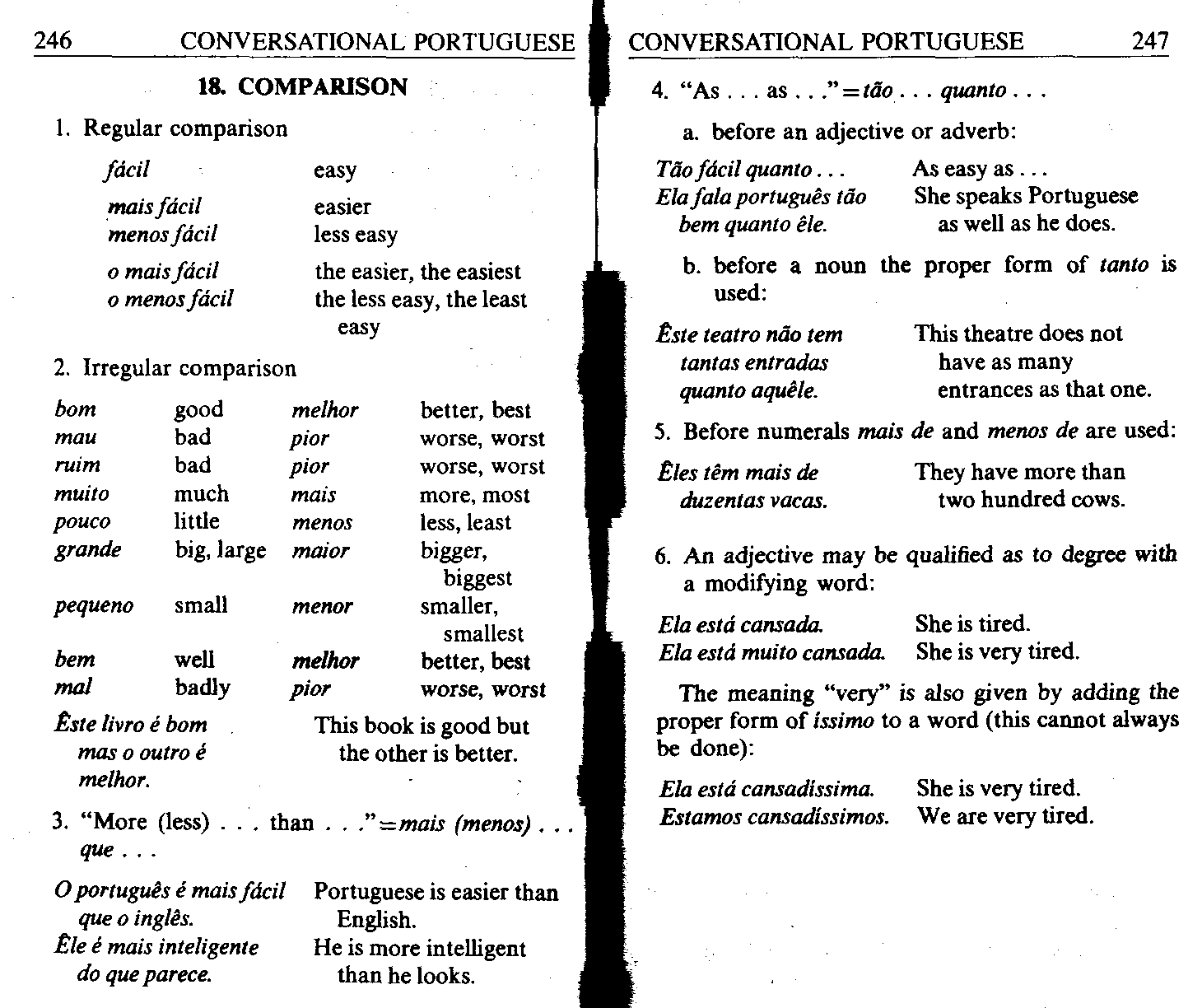Summary p246

246 CONYERSATIONAL PORTUGUESE
1«. COMPAR1SON
1. Rcgular comparison
|
facil |
easy | ||
|
mais facil |
easier | ||
|
menos facil |
less easy | ||
|
o mais fócil |
the easier, the easiest | ||
|
o menos facil |
the less easy, the least | ||
|
easy | |||
|
2. Irregular comparison | |||
|
bom |
good |
melhor |
better, best |
|
mau |
bad |
piór |
worse, worst |
|
ruim |
bad |
piór |
worse, worst |
|
muito |
much |
mais |
morę, most |
|
pouco |
little |
menos |
less, least |
|
grandę |
big,large |
major |
bigger, |
|
biggest | |||
|
peąueno |
smali |
menor |
smaller, |
smallest melhor better, best
piór worse, worst
This book is good but the other is better.
3, “Morę (less) . . . than . , f—mais (menos) . .. que . . .
O portuguis e mais fdcił Portuguese is easier than que o irtgłśs. English.
Ele i mais inteligente He is morę intelligent do que parece. than he looks.
bem well
mai badly
Esie livro e bom mas o outro 4 melhor.
4. “As . . . as . . ” = tao. . . ąuanto. . .
a. before an adjective or adverb:
Tao fdcil ąuanto... As easy as ...
Ela fala portugues tao She speaks Portuguese
bem ąuanto ele. as well as he does.
b. before a noun the proper form of tanto is used:
This theatre does not have as many entrances as that one.
Este teatro nao tem tantas entradas ąuanto aąuile.
5. Before numerals mais de and menos de are used:
£les tem mais de duzentas vacas.
They have morę than two hundred cows.
6. An adjective may be quatified as to degree with a modifying word:
She is tired.
She is very tired.
Ela esta cansada.
Ela estd muito cansada.
The meaning “very” is also given by adding the proper form of issimo to a word (this cannot always be done):
Ela estd cansadissima. She is veiy tired.
Estamos cansadissimos. We are very tired.
Wyszukiwarka
Podobne podstrony:
Summary p222 222 CONYERSATIONAL PORTUGUESE 21. Vamos_(to have dinner). a. jantar
Summary p224 224 CONYERSATIONAL PORTUGUESE (3) variations occur in different areas: a.
Summary p226 226 CONYERSATIONAL PORTUGUESH CONYERSATIONAL PORTUGUESE 227 d g g h j I I Ut m as d i
Summary p230 230 CONYERSATIONAL PORTUGUESE 3, The cedilla (cedilha) is used with
Summary p234 234 CONYERSATIONAL PORTUGUESE k. with parts of the body and articles of clothing inst
Summary p236 236 CONYERSATIONAL PORTUGUESE De and em combine with the demonstrative forms (see GS2
Summary p238 238 CONYERSATIONAL PORTUGUESE 13. MASCULINE AND FEMININE 238 CONYERSATIONAL PORTUGUES
Summary p240 240 CONYERSATIONAL PORTUGUESE 14. THE PLURAL 1. Nouns ending in a vowel, including na
Summary p242 242 CONYERSATIONAL PORTUGUESE seu can also be used to translate “his,” “her,” “their.
Summary p248 248 CONYERSATIONAL PORTUGUESE 19. PRONOUNS Pronouns have varying forms depending on w
Summary p250 250 CONYERSATIONAL PORTUGUESE CONYERSATIONAL PORTUGUESE_ 251 (te) I
Summary p254 254 CONYERSATIONAL PORTUGUESE Nao me escreva mais. Eles decidiram que nos mandar
Summary p256 256 CONYERSATIONAL PORTUGUESE 21. SOME CONJUNCTIONS ainda que assim que ate
Summary p258 258 CONYERSATIONAL PORTUGUESE 23. ADYERBS 1. Some Portuguese adverbs are formed by ad
Summary p260 260 CONYERSATIONAL PORTUGUESE la (acold) there (morę remote) adiante . forward,
Summary p262 262 CONYERSATIONAL PORTUGUESE sabdo soap sabonete a cake of toilet
Summary p264 264 CONYERSATIONAL PORTUGUESE Ndo ąuero este sem I don’t want this one
Summary p266 266 CONYERSATIONAL PORTUGUESE27. NEGATION 1. Ndo “not” comes before
Summary p268 268 CONYERSATIONAL PORTUGUESE 2. The personal infinitiye has endings which make it ea
więcej podobnych podstron